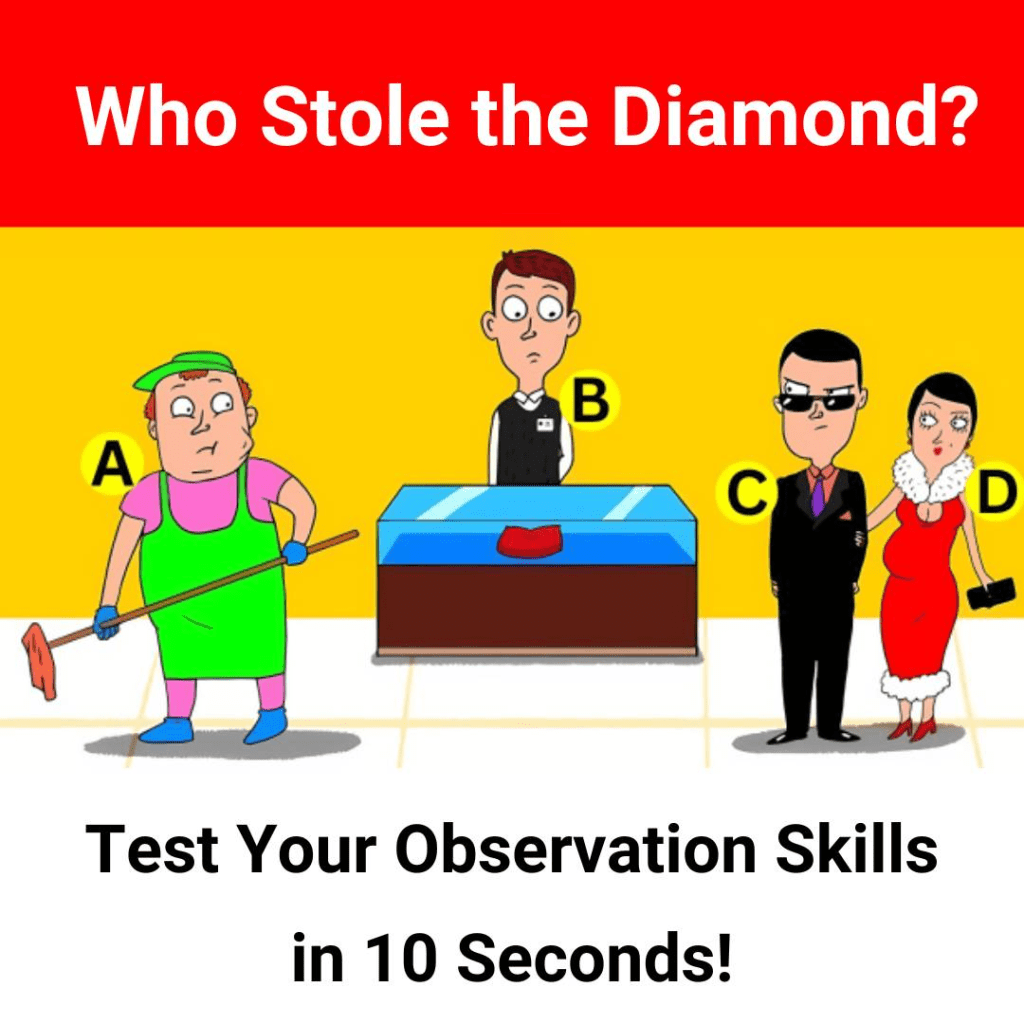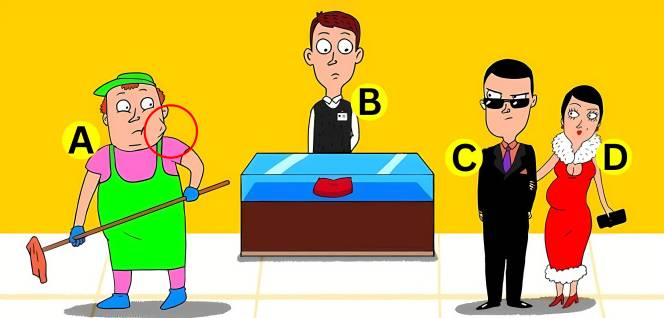A priceless diamond has vanished, and four suspects are in the spotlight: A, B, C, and D. The scene is set, the stakes are high, and it’s up to you to uncover the truth. Think you’ve got what it takes? Examine the image closely, analyze every detail, and see if you can identify the culprit in just 10 seconds. Let’s dive into this interactive mystery!
Are your detective skills sharp enough to crack the case? Let’s break it all down step by step and reveal who the diamond thief is.

Common Mistakes in Solving Mystery Puzzles
Before we dive into the solution, let’s talk about the common pitfalls people face when solving puzzles like this one. If you’ve tried to solve it but ended up with the wrong answer, you’re not alone. Here are some frequent mistakes that lead to confusion:
- Judging by appearances: Many people assume the most suspicious-looking character is guilty. But in puzzles like this, looks can be deceiving. For instance, a serious expression or flashy outfit doesn’t necessarily mean someone is the thief.
- Missing subtle clues: Often, the solution lies in the smallest, most easily overlooked details. If you didn’t notice a tiny hint, you might have missed the key to solving the mystery.
- Overthinking the puzzle: Some people create elaborate theories or convoluted explanations when the actual answer is much simpler. Staying focused on the evidence is essential.
If any of these sound familiar, don’t worry—you’re about to learn how to solve this puzzle like a pro.
Step-by-Step Analysis: Who Are the Suspects?
Now that we’ve addressed common mistakes, let’s analyze each suspect one by one. Pay close attention to the details, and we’ll uncover the truth together.
Suspect A: The Cleaner
At first glance, suspect A seems innocent—just a cleaner with a mop, right? But look closer. What’s that in their mouth? If you pay attention, you’ll notice that suspect A appears to be clenching something. Could it be the missing diamond? This subtle yet crucial detail makes A the prime suspect.
Their proximity to the scene and their attempt to appear inconspicuous suggest they’re trying to hide something. Even their slightly nervous expression hints at guilt. The evidence points strongly to suspect A as the thief.
Suspect B: The Shopkeeper
Suspect B, the shopkeeper, stands behind the display case where the diamond was taken. Their shocked and confused expression might raise suspicion, but there’s no direct evidence linking them to the theft. Their reaction seems genuine—they’re more worried about the missing diamond than guilty of stealing it. For now, we can rule them out.
Suspect C: The Bodyguard
Suspect C, the bodyguard, has a stern expression and wears dark glasses, which might make them look intimidating. However, there’s no indication they interacted with the diamond. They seem to be standing guard, doing their job, rather than engaging in any suspicious behavior. Their posture and demeanor don’t connect them to the crime.
Suspect D: The Glamorous Woman
Suspect D, dressed in a striking red outfit, might catch your eye as a potential thief. But a closer look shows no evidence tying her to the missing diamond. Her hands are visible, and her confident pose suggests she’s more of a bystander than a culprit. While her dramatic appearance might draw suspicion, there’s nothing to prove she committed the crime.
The Verdict: Suspect A Stole the Diamond

After examining all four suspects, it’s clear that suspect A is the thief. The key detail lies in their mouth, which appears to be hiding the diamond. This small but critical clue reveals their guilt and explains their nervous behavior. Sometimes, the most innocent-looking characters are the ones hiding the biggest secrets.
Why Subtle Clues Matter in Puzzles
This puzzle highlights the importance of paying attention to details. In many cases, the solution is hidden in plain sight, but only the sharpest observers notice it. By focusing on small hints—like suspect A’s mouth—you can uncover the truth even when it’s well-concealed.
Did You Solve the Mystery?
So, did you crack the case, or were you misled by one of the other suspects? Share your answer in the comments! Did you catch the detail in suspect A’s mouth, or were you distracted by the other characters’ appearances? Puzzles like this are not only fun but also a great way to sharpen your observational and logical thinking skills.
Why not challenge your friends to solve this mystery too? See who can figure it out fastest and compare your detective skills!
The Fun of Solving Puzzles
Mystery puzzles like this one aren’t just entertaining—they’re an excellent exercise for your brain. They encourage you to think critically, pay attention to detail, and approach problems from different angles. Whether you solve the puzzle right away or need a little extra time, the challenge itself is a rewarding experience.
Plus, puzzles like this are perfect for social media. They’re shareable, engaging, and spark friendly competition among friends and followers. Who doesn’t love a good brain-teaser?
Conclusion: Keep Challenging Yourself
The mystery of the missing diamond is just one example of how puzzles can spark curiosity and challenge your mind. By analyzing every detail, avoiding assumptions, and staying focused, you can solve even the trickiest mysteries. Whether you solved this one or not, the important thing is to keep practicing and sharpening your skills.
Ready for your next puzzle? Stay tuned for more brain-teasers and challenges that will put your detective skills to the test. And don’t forget to share this post with your friends—let’s see who has what it takes to uncover the next big mystery!


